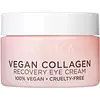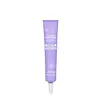What's inside
What's inside
 Key Ingredients
Key Ingredients

 Benefits
Benefits

 Concerns
Concerns

 Ingredients Side-by-side
Ingredients Side-by-side

Water
Skin ConditioningCetearyl Olivate
Caprylic/Capric Triglyceride
MaskingCetearyl Alcohol
EmollientGlycerin
HumectantSorbitan Olivate
EmulsifyingGlyceryl Caprylate
EmollientGlyceryl Stearate Se
EmulsifyingSr-Hydrozoan Polypeptide-1
HumectantChamomilla Recutita Flower Extract
MaskingCalendula Officinalis Flower Extract
MaskingCitrus Aurantium Dulcis Flower Extract
Skin ConditioningRosmarinus Officinalis Leaf Extract
AntimicrobialHydrolyzed Brassica Napus Seedcake Extract
Skin ConditioningJasminum Officinale Flower Extract
MaskingArnica Montana Flower Extract
MaskingLeuconostoc/Radish Root Ferment Filtrate
AntimicrobialCamellia Oleifera Seed Oil
Skin ConditioningHydrolyzed Jojoba Esters
Skin ConditioningCaffeine
Skin ConditioningAllantoin
Skin ConditioningPanthenol
Skin ConditioningSodium Hyaluronate
HumectantTocopherol
AntioxidantQuartz
AbrasiveOpuntia Ficus-Indica Seed Oil
EmollientArginine
MaskingBentonite
AbsorbentCoconut Alkanes
EmollientCoco-Caprylate/Caprate
EmollientCetyl Esters
EmollientStearic Acid
CleansingCetearyl Glucoside
EmulsifyingXanthan Gum
EmulsifyingMaltodextrin
AbsorbentGlucose
HumectantPhenoxyethanol
PreservativePotassium Sorbate
PreservativeSodium Benzoate
MaskingWater, Cetearyl Olivate, Caprylic/Capric Triglyceride, Cetearyl Alcohol, Glycerin, Sorbitan Olivate, Glyceryl Caprylate, Glyceryl Stearate Se, Sr-Hydrozoan Polypeptide-1, Chamomilla Recutita Flower Extract, Calendula Officinalis Flower Extract, Citrus Aurantium Dulcis Flower Extract, Rosmarinus Officinalis Leaf Extract, Hydrolyzed Brassica Napus Seedcake Extract, Jasminum Officinale Flower Extract, Arnica Montana Flower Extract, Leuconostoc/Radish Root Ferment Filtrate, Camellia Oleifera Seed Oil, Hydrolyzed Jojoba Esters, Caffeine, Allantoin, Panthenol, Sodium Hyaluronate, Tocopherol, Quartz, Opuntia Ficus-Indica Seed Oil, Arginine, Bentonite, Coconut Alkanes, Coco-Caprylate/Caprate, Cetyl Esters, Stearic Acid, Cetearyl Glucoside, Xanthan Gum, Maltodextrin, Glucose, Phenoxyethanol, Potassium Sorbate, Sodium Benzoate
Water
Skin ConditioningGlycerin
HumectantPalmitoyl Tripeptide-5
Skin ConditioningCetyl Alcohol
EmollientSqualane
EmollientHelianthus Annuus Seed Oil
EmollientTocopheryl Acetate
AntioxidantStearyl Alcohol
EmollientGlycolipids
Skin ConditioningGlyceryl Stearate Citrate
EmollientGlyceryl Laurate
EmollientCeramide NP
Skin ConditioningCeramide AP
Skin ConditioningCeramide EOP
Skin ConditioningPhytosphingosine
Skin ConditioningCholesterol
EmollientSodium Lauroyl Lactylate
EmulsifyingCalendula Officinalis Flower Extract
MaskingAlthaea Officinalis Root Extract
Skin ConditioningCaffeine
Skin ConditioningAloe Barbadensis Leaf Juice
Skin ConditioningTocopherol
AntioxidantSorbitan Sesquioleate
EmulsifyingAllantoin
Skin ConditioningPanthenol
Skin ConditioningXanthan Gum
EmulsifyingGlyceryl Stearate
EmollientPhenoxyethanol
PreservativeEthylhexylglycerin
Skin ConditioningWater, Glycerin, Palmitoyl Tripeptide-5, Cetyl Alcohol, Squalane, Helianthus Annuus Seed Oil, Tocopheryl Acetate, Stearyl Alcohol, Glycolipids, Glyceryl Stearate Citrate, Glyceryl Laurate, Ceramide NP, Ceramide AP, Ceramide EOP, Phytosphingosine, Cholesterol, Sodium Lauroyl Lactylate, Calendula Officinalis Flower Extract, Althaea Officinalis Root Extract, Caffeine, Aloe Barbadensis Leaf Juice, Tocopherol, Sorbitan Sesquioleate, Allantoin, Panthenol, Xanthan Gum, Glyceryl Stearate, Phenoxyethanol, Ethylhexylglycerin
Ingredients Explained
These ingredients are found in both products.
Ingredients higher up in an ingredient list are typically present in a larger amount.
Allantoin is a soothing ingredient known for its protective and moisturizingg properties. Because of this, it is often added to products with strong active ingredients.
Studies show higher concentrations of this ingredient can promote wound healing.
Though it can be derived from the comfrey plant, allantoin is produced synthetically for cosmetic products to ensure purity.
Learn more about AllantoinCaffeine is most associated with coffee, tea, and cacao. In skincare, it helps with calming inflammation and is rich in antioxidants.
While caffeine is used to treat cellulite and and dark circles, further studies are needed to prove this. It has been believed to help with these skin conditions due to its ability to dilate blood vessels and increase blood flow.
Some studies are looking into caffeine's ability to protect against UV rays.
Learn more about CaffeineCalendula Officinalis Flower Extract comes from the common Marigold plant. This ingredient is a skin conditioner.
Marigolds contain flavonoids. Flavonoids are a group of substances found naturally in plants. They possess antioxidant and inflammation properties.
This ingredient soothes skin inflammation by inhibiting inhibiting a part of the inflammation process.
Marigolds have been used in traditional medicine throughout Asia and Europe.
Learn more about Calendula Officinalis Flower ExtractGlycerin is already naturally found in your skin. It helps moisturize and protect your skin.
A study from 2016 found glycerin to be more effective as a humectant than AHAs and hyaluronic acid.
As a humectant, it helps the skin stay hydrated by pulling moisture to your skin. The low molecular weight of glycerin allows it to pull moisture into the deeper layers of your skin.
Hydrated skin improves your skin barrier; Your skin barrier helps protect against irritants and bacteria.
Glycerin has also been found to have antimicrobial and antiviral properties. Due to these properties, glycerin is often used in wound and burn treatments.
In cosmetics, glycerin is usually derived from plants such as soybean or palm. However, it can also be sourced from animals, such as tallow or animal fat.
This ingredient is organic, colorless, odorless, and non-toxic.
Glycerin is the name for this ingredient in American English. British English uses Glycerol/Glycerine.
Learn more about GlycerinPanthenol is a common ingredient that helps hydrate and soothe the skin. It is found naturally in our skin and hair.
There are two forms of panthenol: D and L.
D-panthenol is also known as dexpanthenol. Most cosmetics use dexpanthenol or a mixture of D and L-panthenol.
Panthenol is famous due to its ability to go deeper into the skin's layers. Using this ingredient has numerous pros (and no cons):
Like hyaluronic acid, panthenol is a humectant. Humectants are able to bind and hold large amounts of water to keep skin hydrated.
This ingredient works well for wound healing. It works by increasing tissue in the wound and helps close open wounds.
Once oxidized, panthenol converts to pantothenic acid. Panthothenic acid is found in all living cells.
This ingredient is also referred to as pro-vitamin B5.
Learn more about PanthenolPhenoxyethanol is a preservative that has germicide, antimicrobial, and aromatic properties. Studies show that phenoxyethanol can prevent microbial growth. By itself, it has a scent that is similar to that of a rose.
It's often used in formulations along with Caprylyl Glycol to preserve the shelf life of products.
Tocopherol (also known as Vitamin E) is a common antioxidant used to help protect the skin from free-radicals and strengthen the skin barrier. It's also fat soluble - this means our skin is great at absorbing it.
Vitamin E also helps keep your natural skin lipids healthy. Your lipid skin barrier naturally consists of lipids, ceramides, and fatty acids. Vitamin E offers extra protection for your skin’s lipid barrier, keeping your skin healthy and nourished.
Another benefit is a bit of UV protection. Vitamin E helps reduce the damage caused by UVB rays. (It should not replace your sunscreen). Combining it with Vitamin C can decrease sunburned cells and hyperpigmentation after UV exposure.
You might have noticed Vitamin E + C often paired together. This is because it is great at stabilizing Vitamin C. Using the two together helps increase the effectiveness of both ingredients.
There are often claims that Vitamin E can reduce/prevent scarring, but these claims haven't been confirmed by scientific research.
Learn more about TocopherolWater. It's the most common cosmetic ingredient of all. You'll usually see it at the top of ingredient lists, meaning that it makes up the largest part of the product.
So why is it so popular? Water most often acts as a solvent - this means that it helps dissolve other ingredients into the formulation.
You'll also recognize water as that liquid we all need to stay alive. If you see this, drink a glass of water. Stay hydrated!
Learn more about WaterXanthan gum is used as a stabilizer and thickener within cosmetic products. It helps give products a sticky, thick feeling - preventing them from being too runny.
On the technical side of things, xanthan gum is a polysaccharide - a combination consisting of multiple sugar molecules bonded together.
Xanthan gum is a pretty common and great ingredient. It is a natural, non-toxic, non-irritating ingredient that is also commonly used in food products.
Learn more about Xanthan Gum